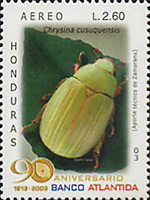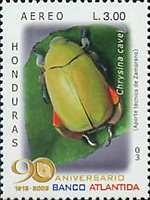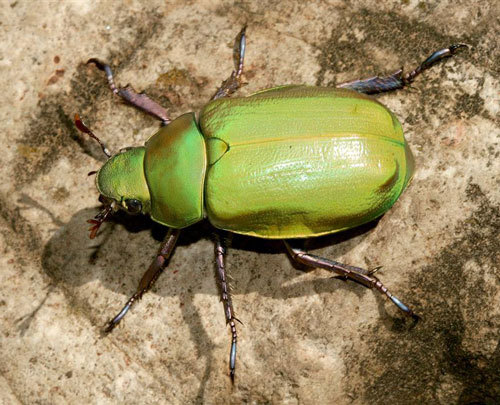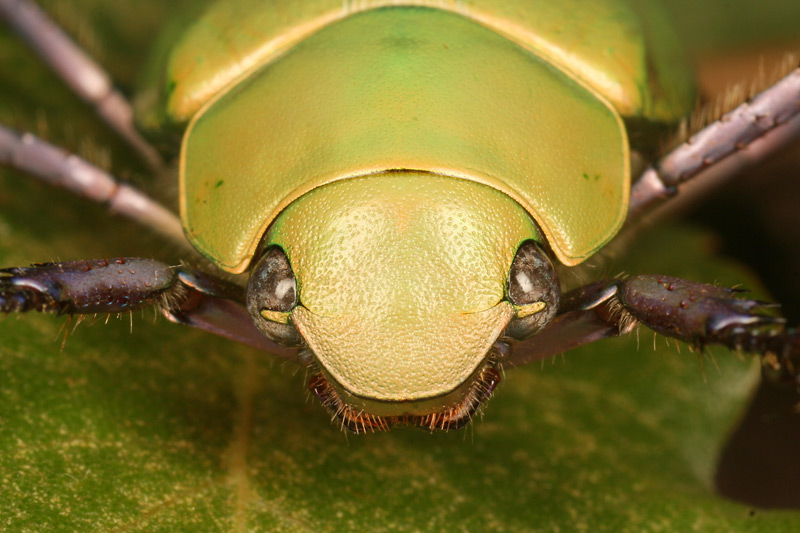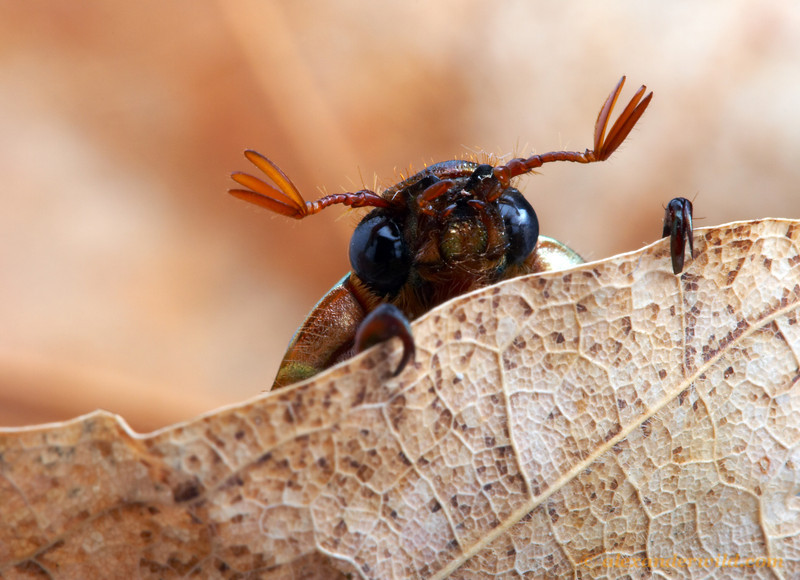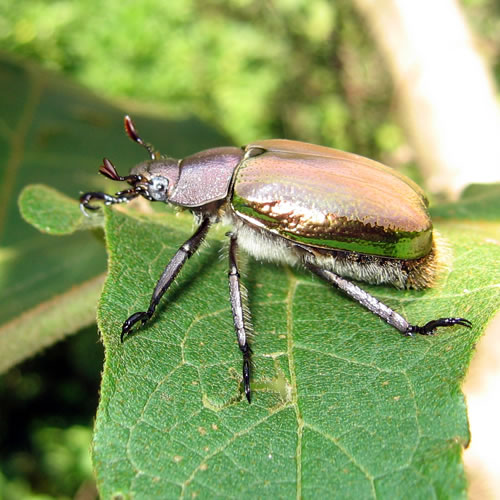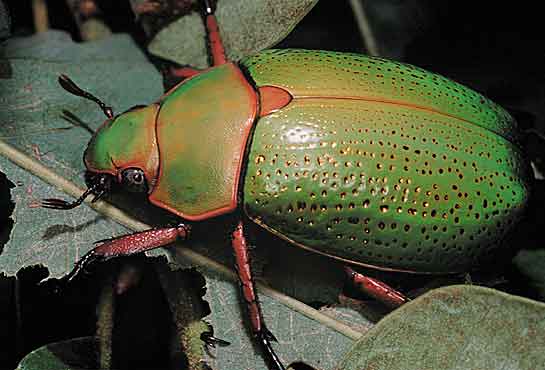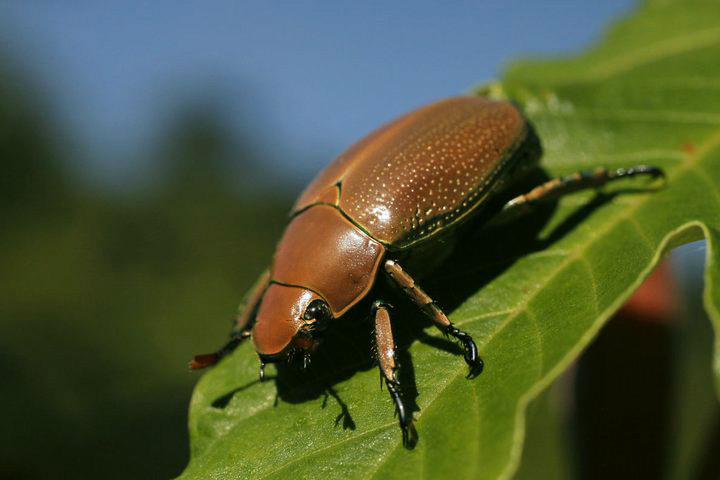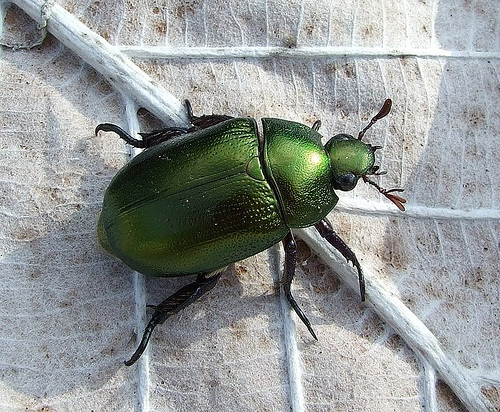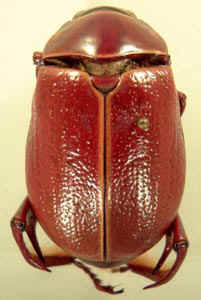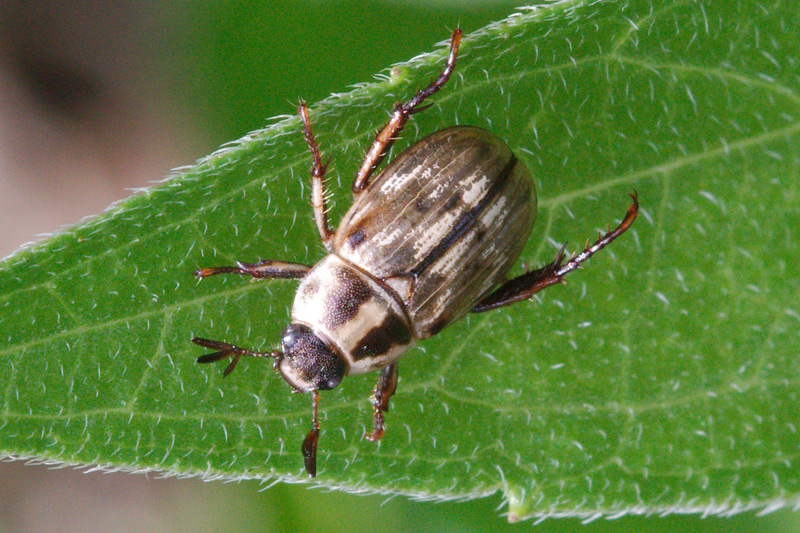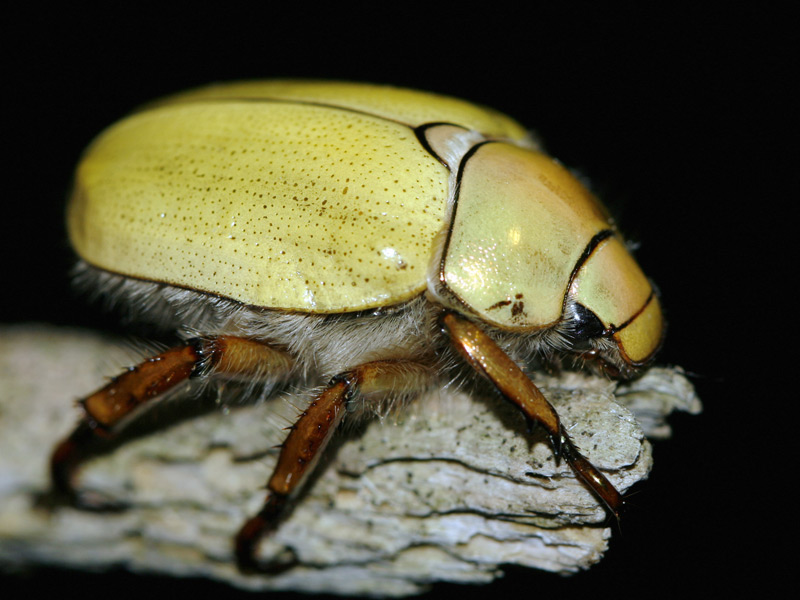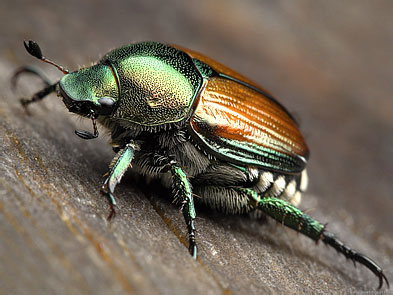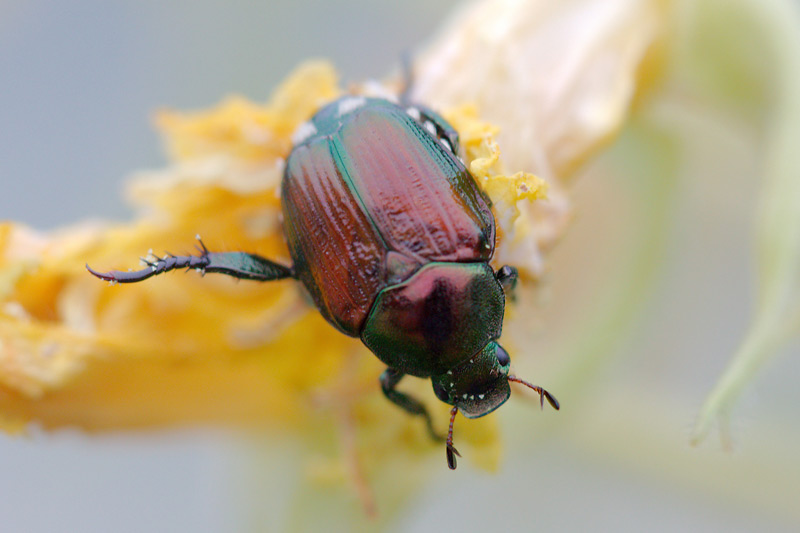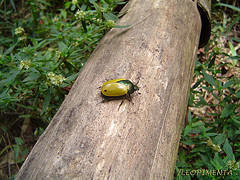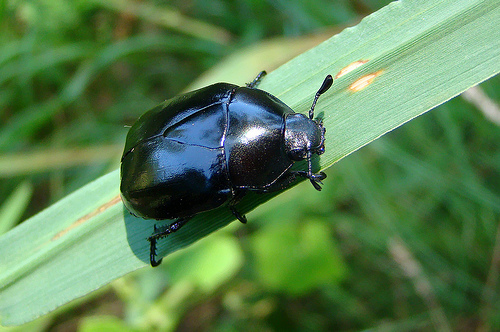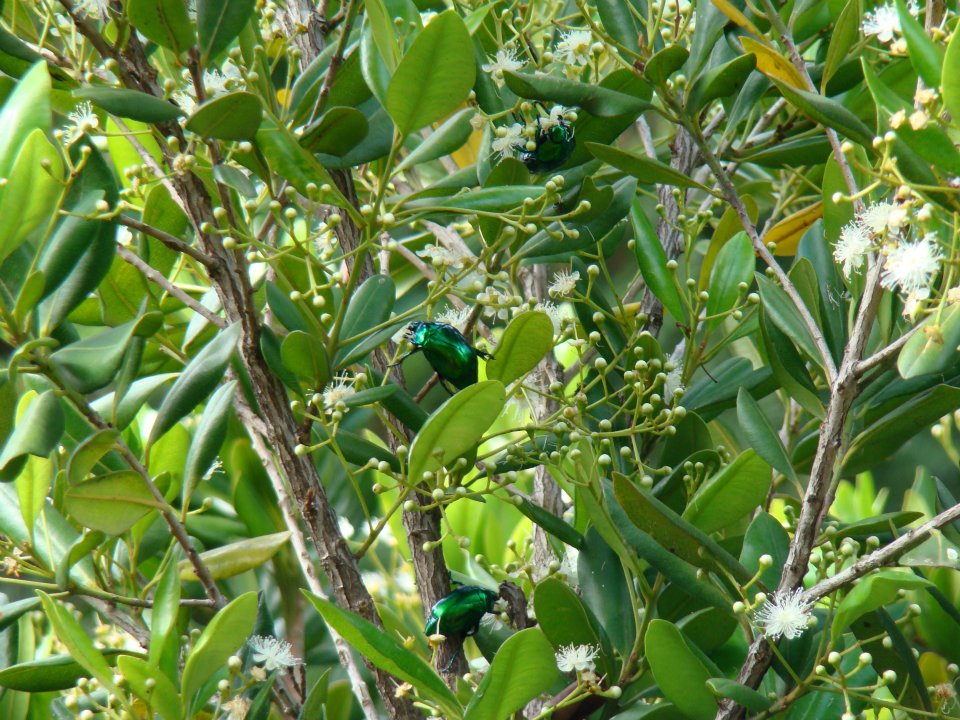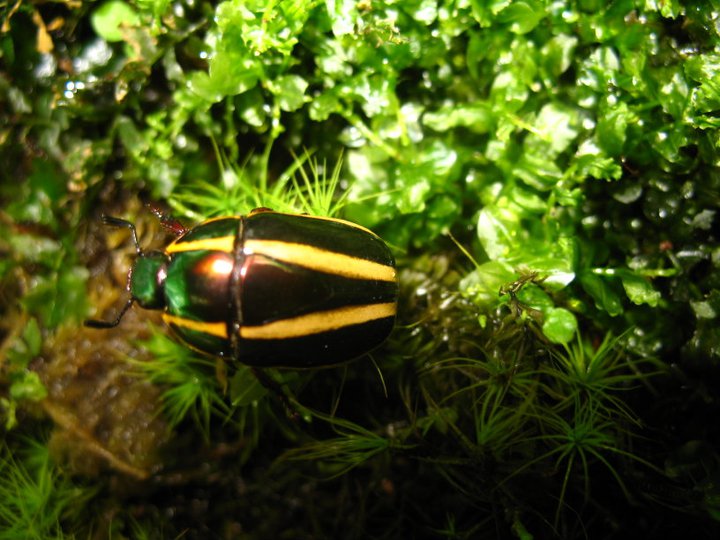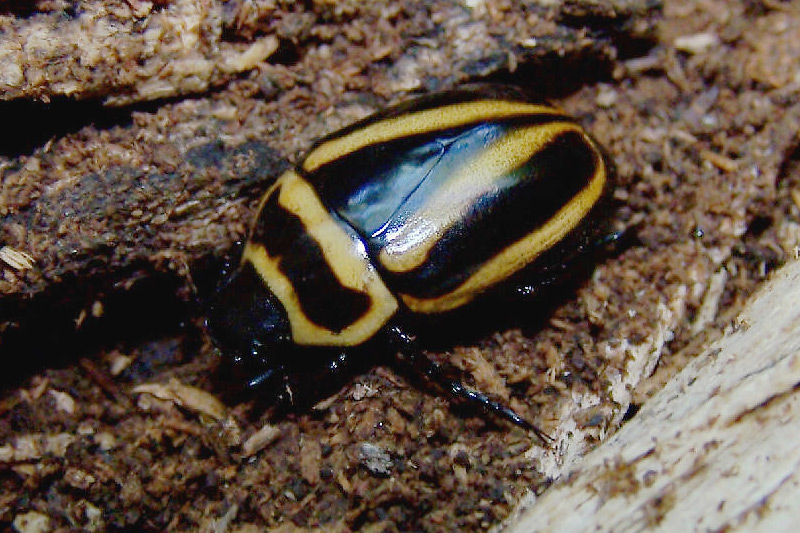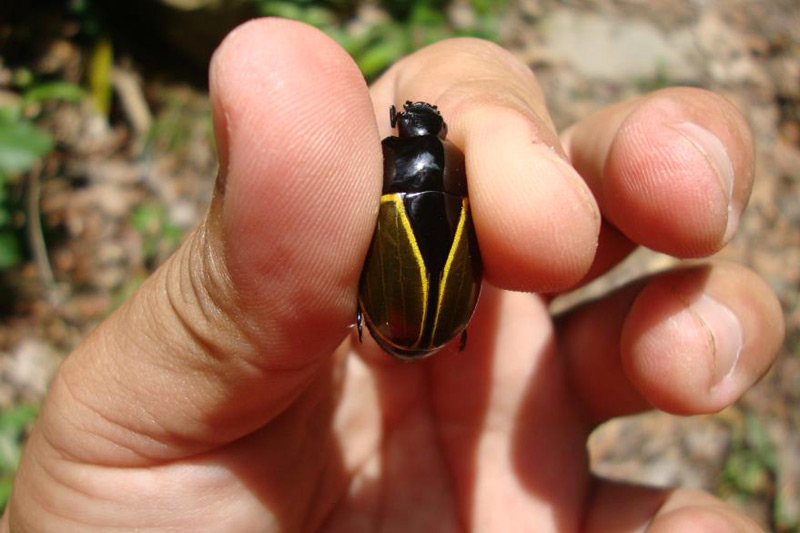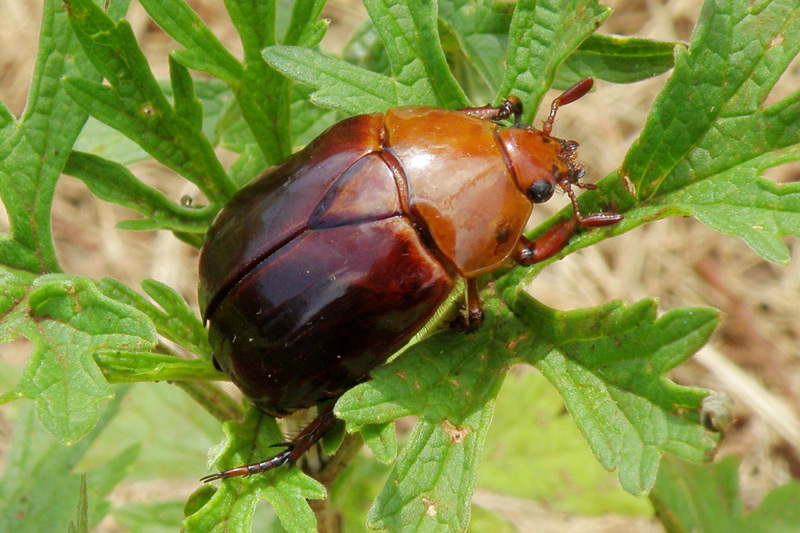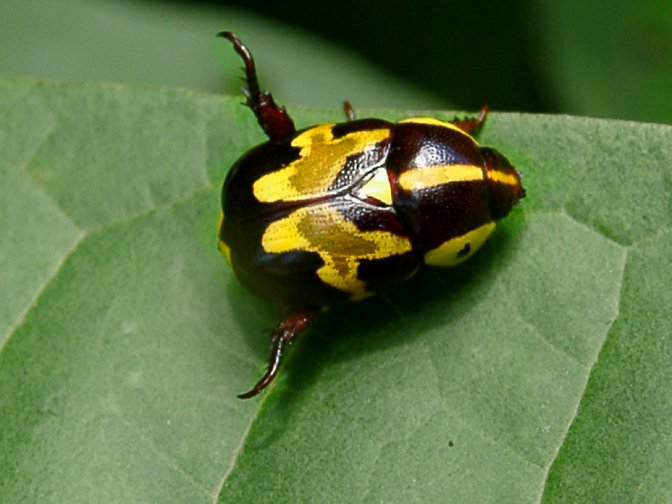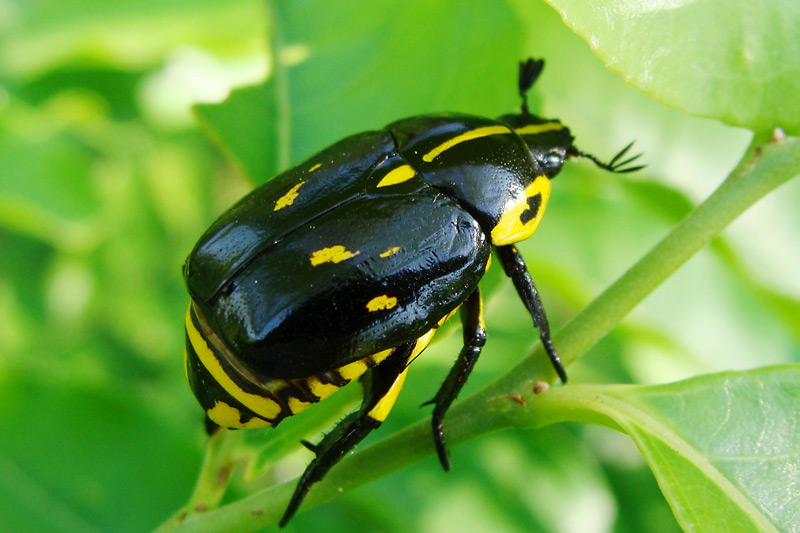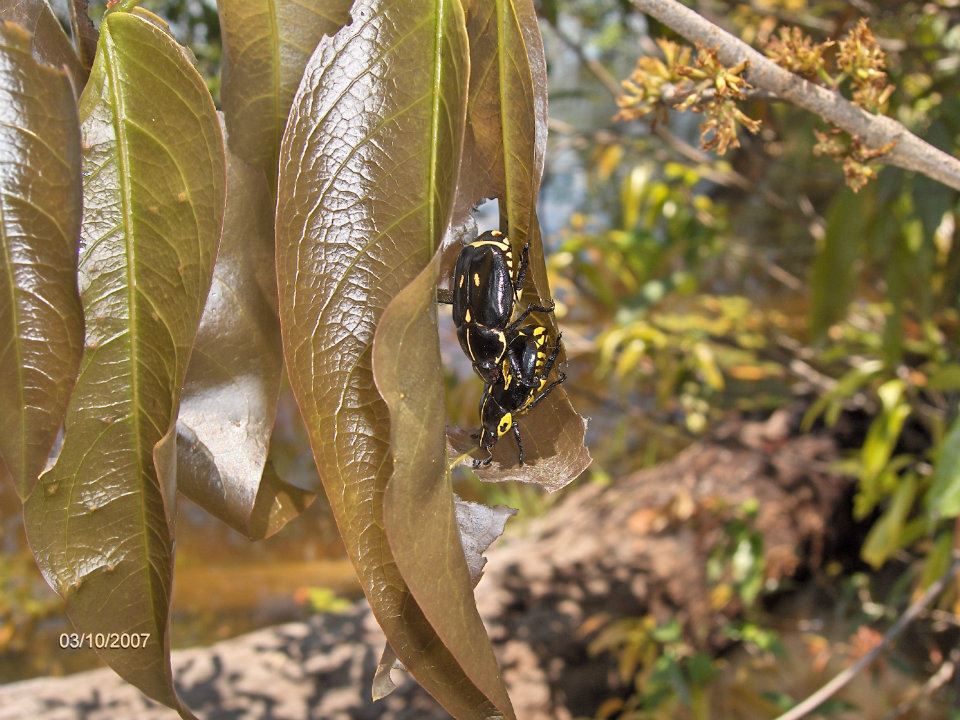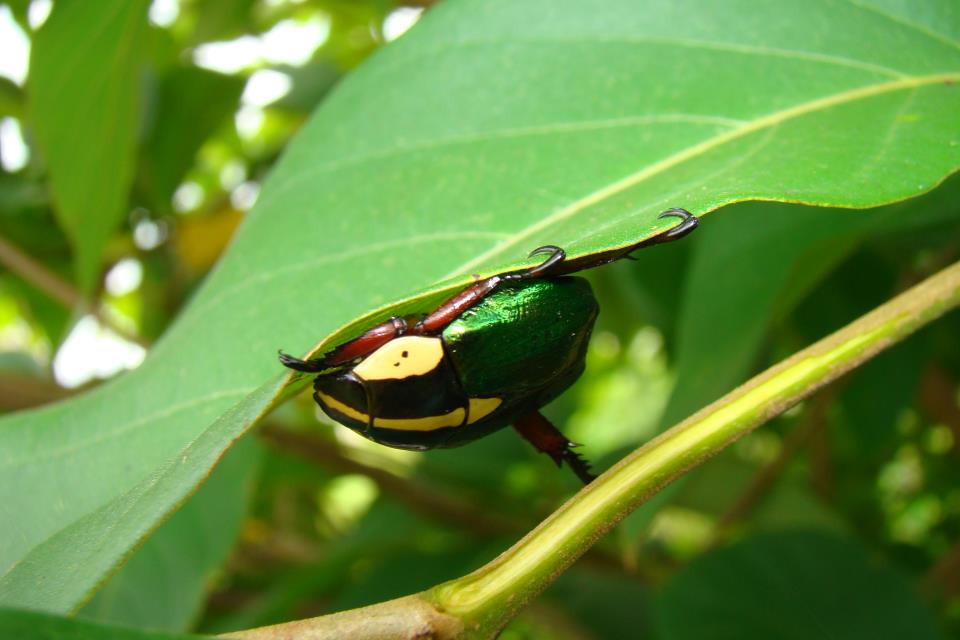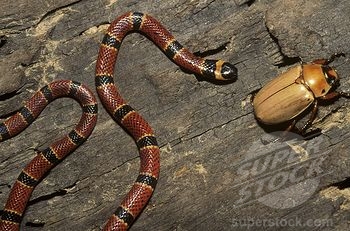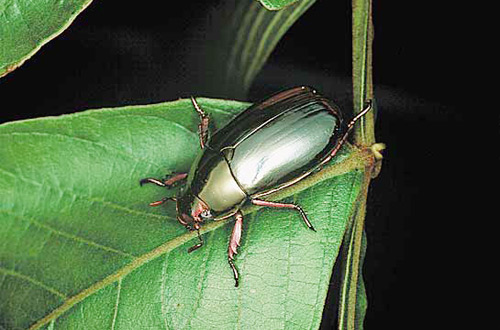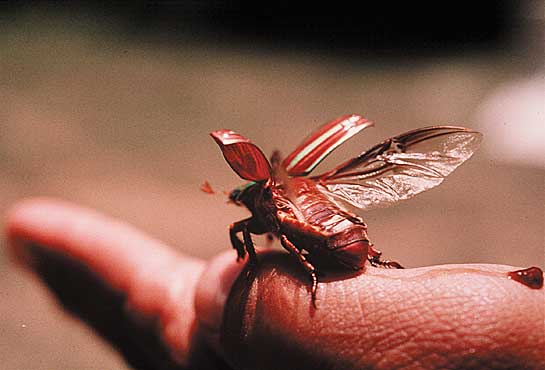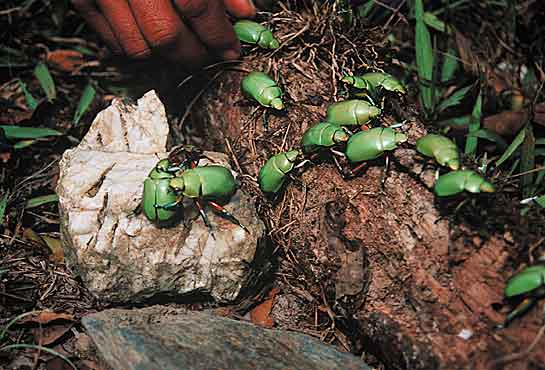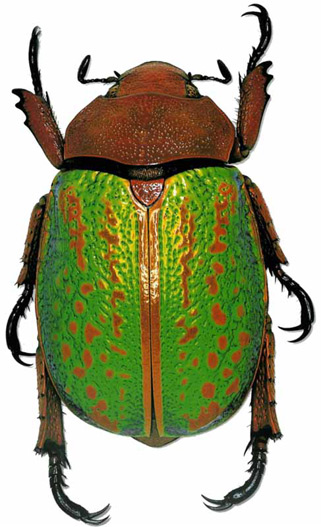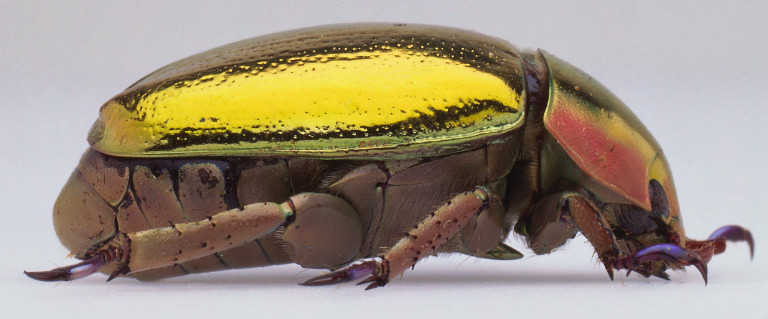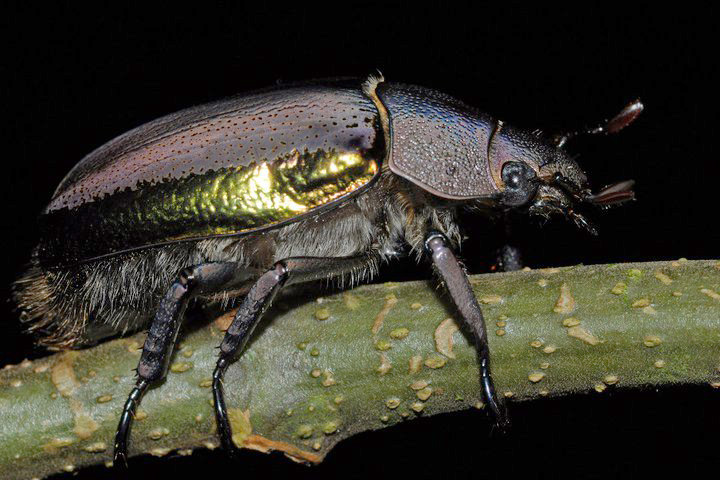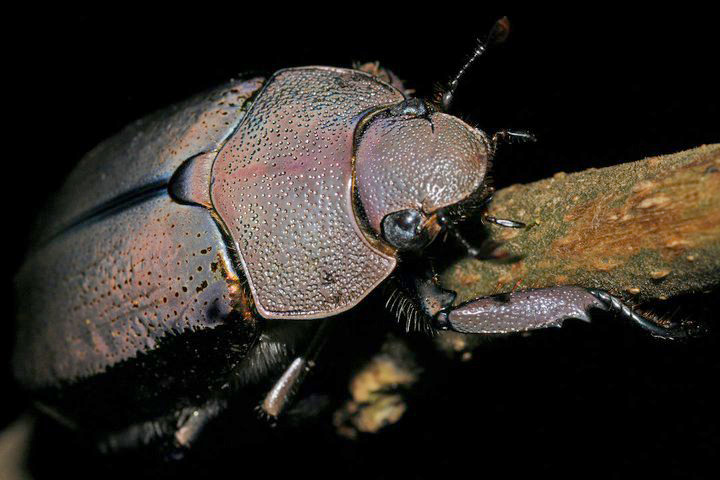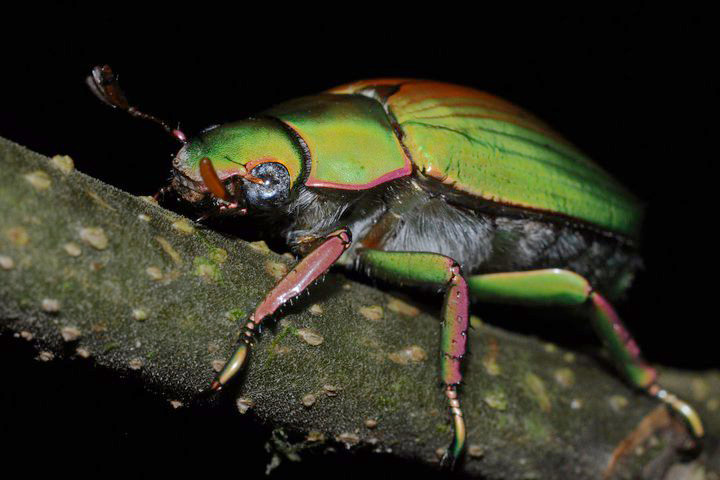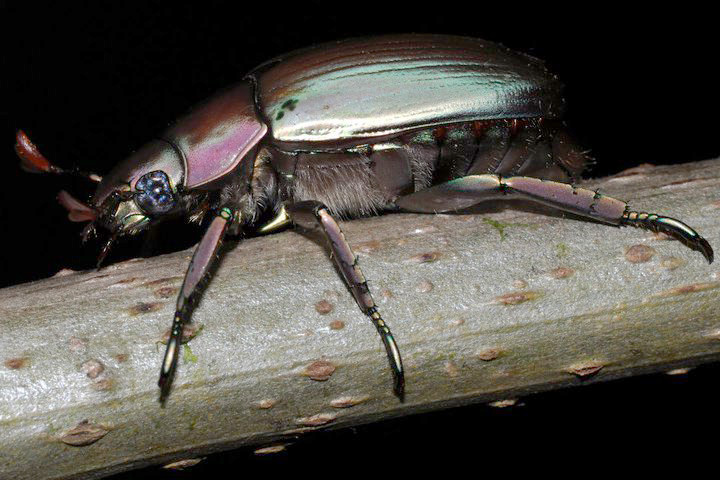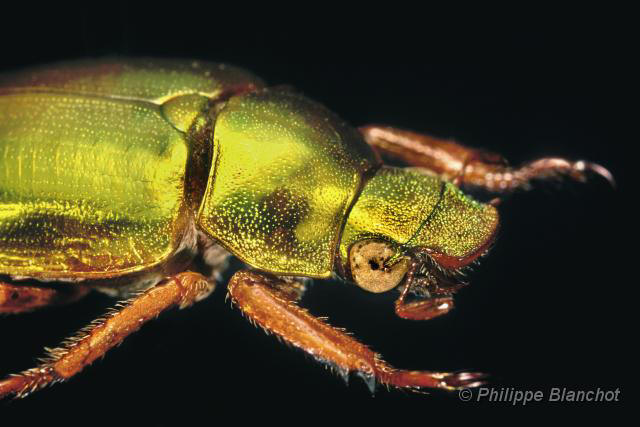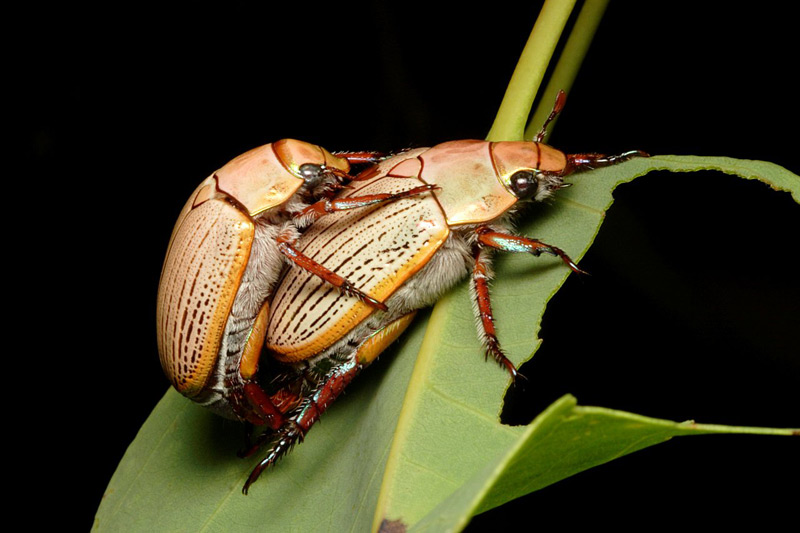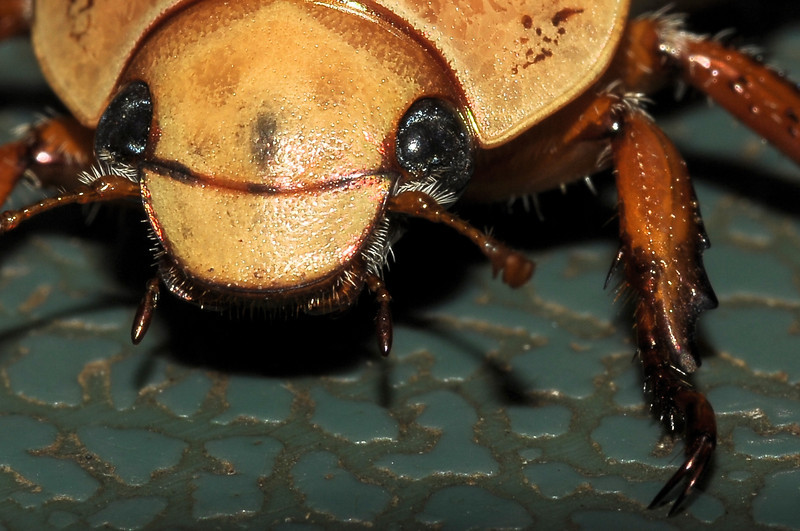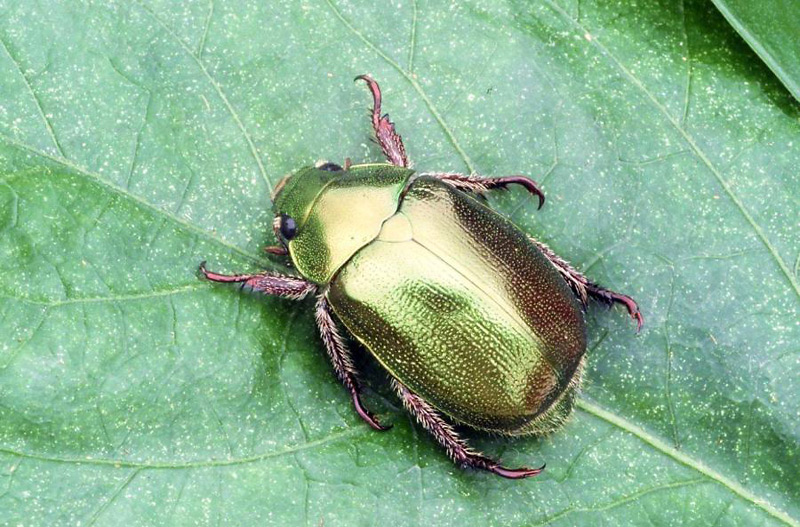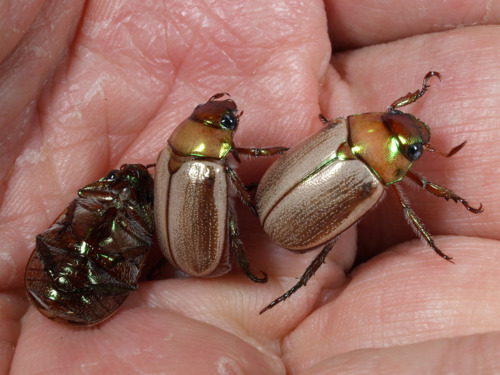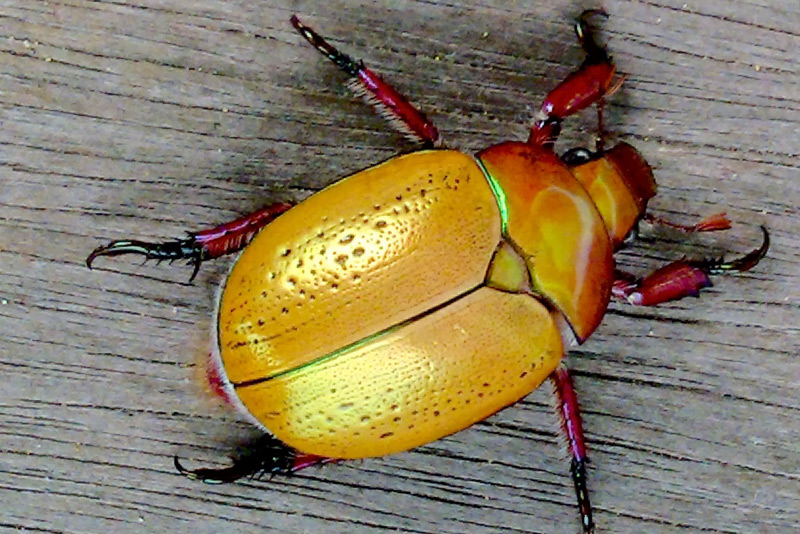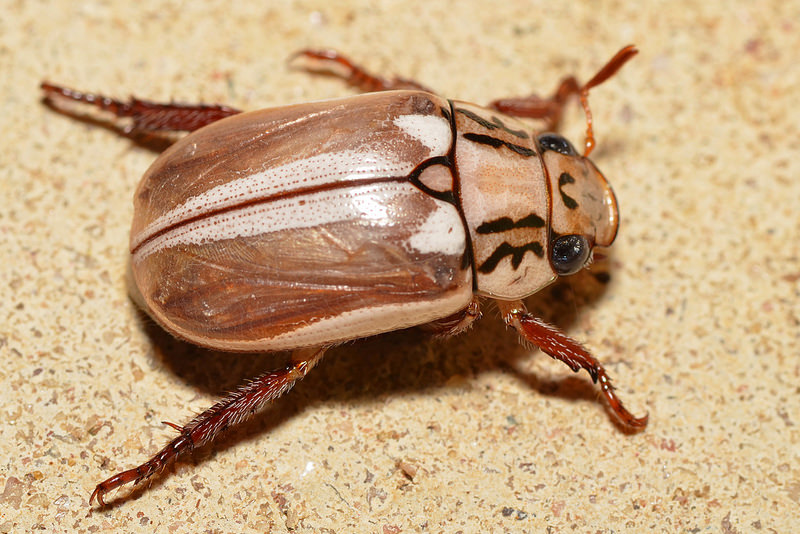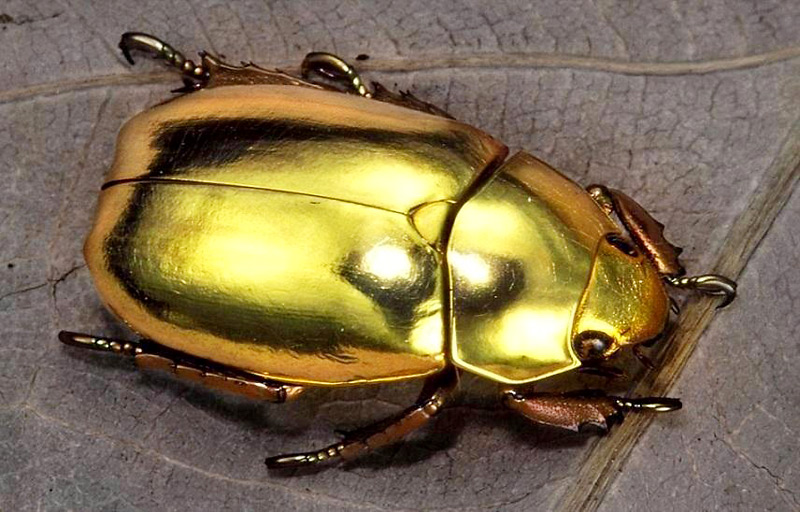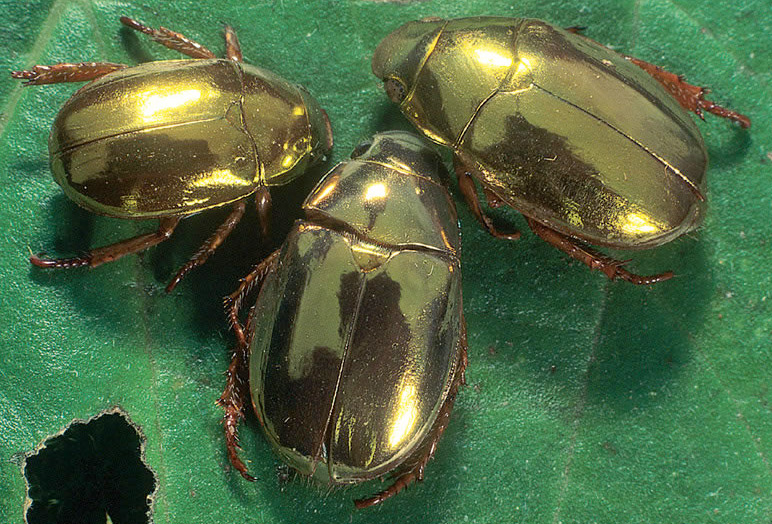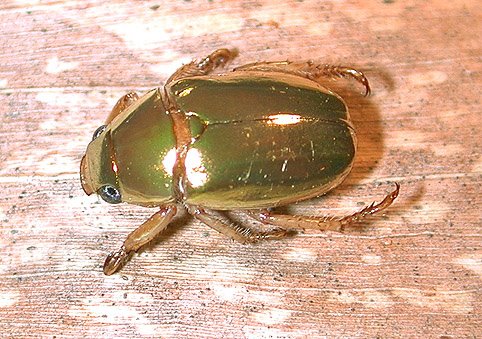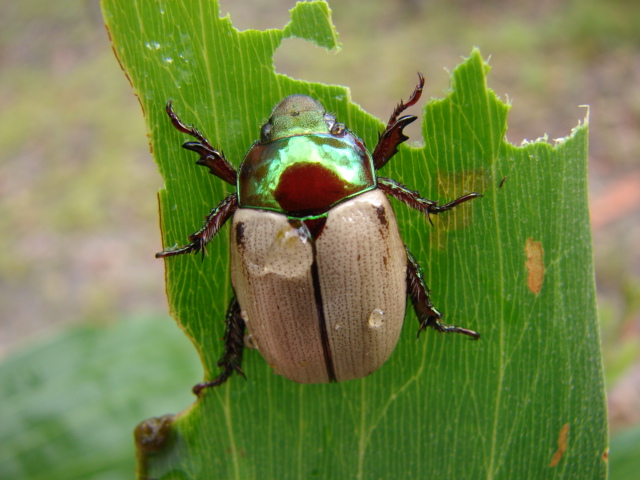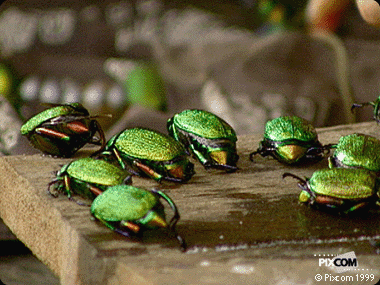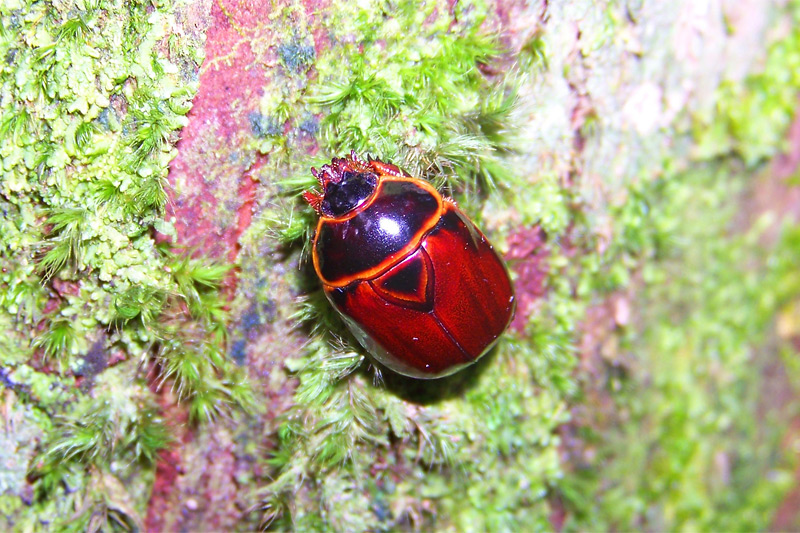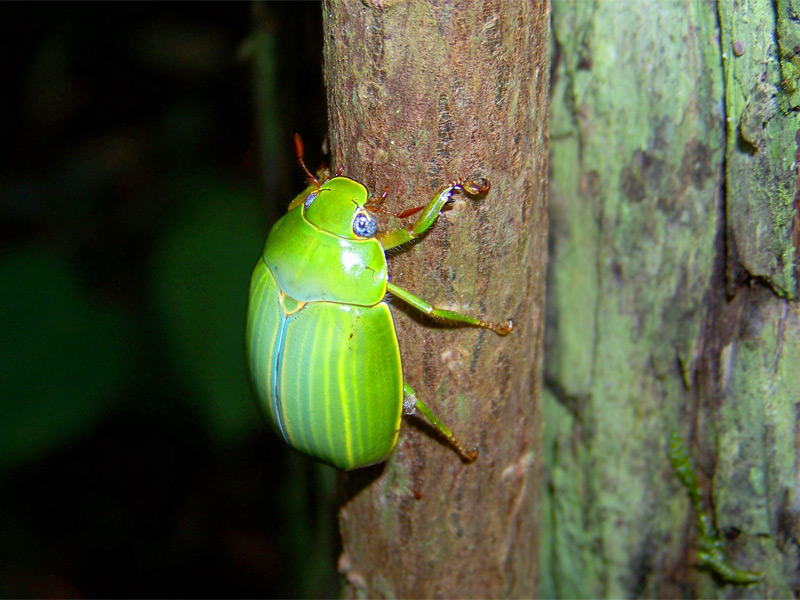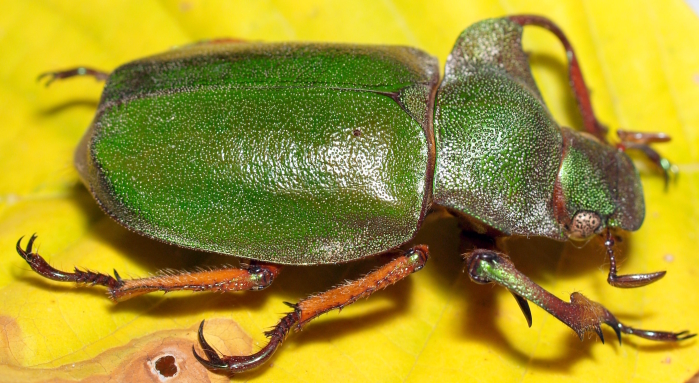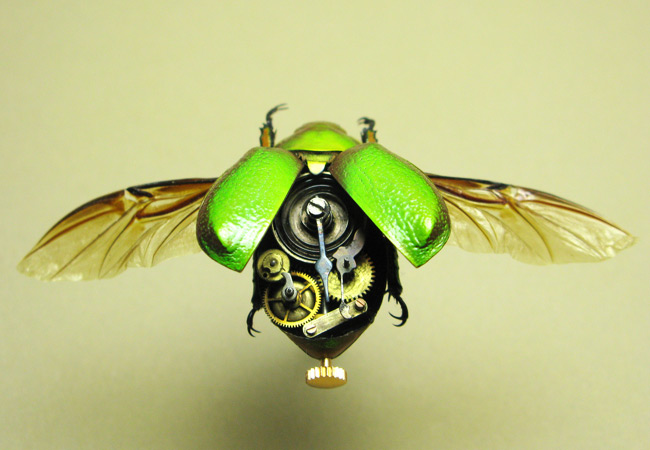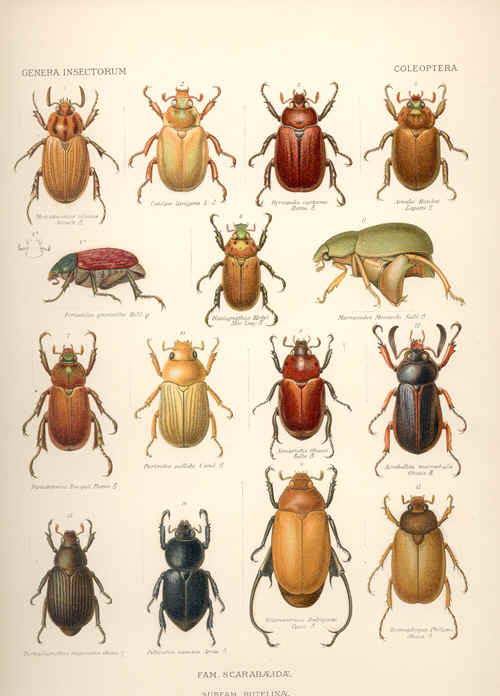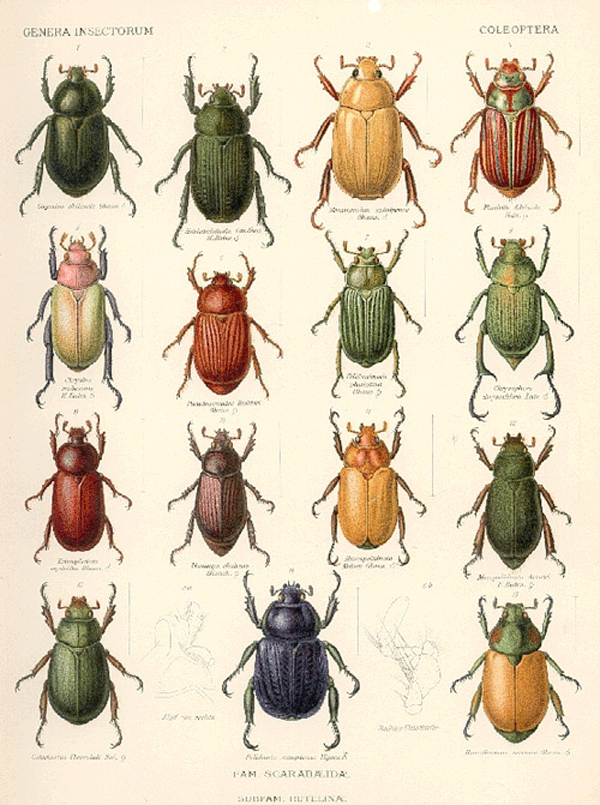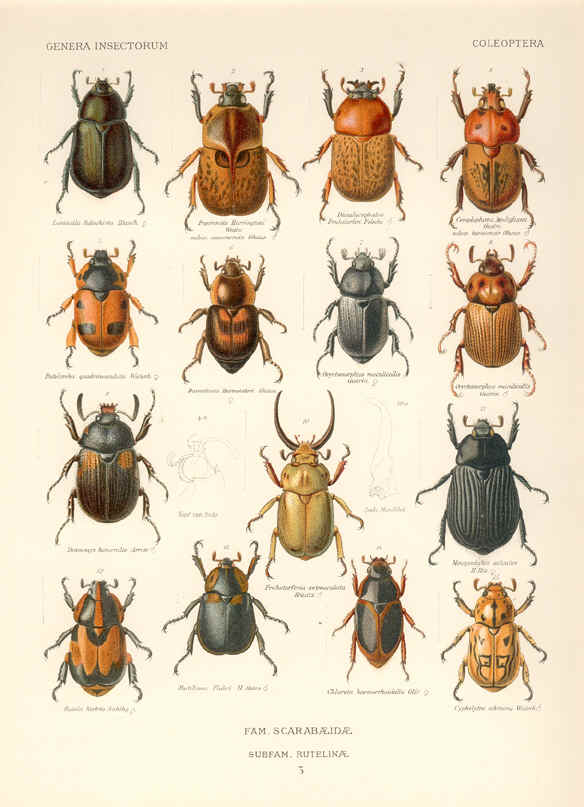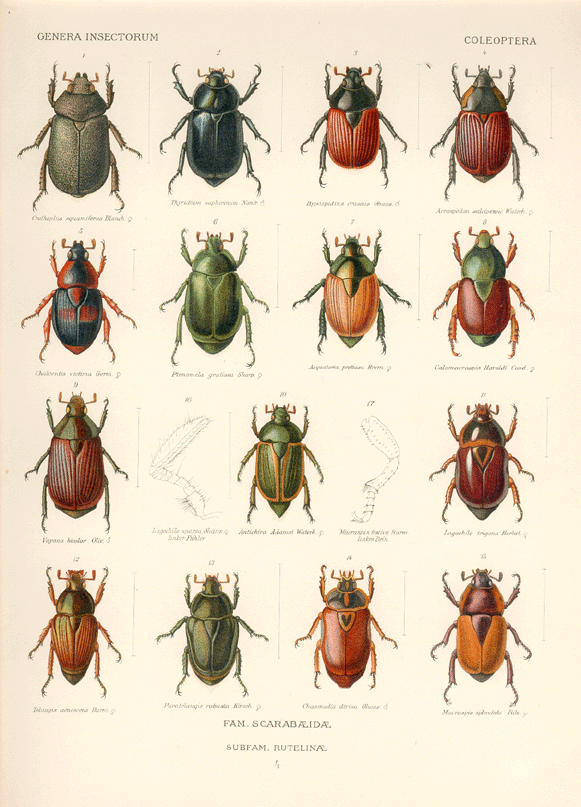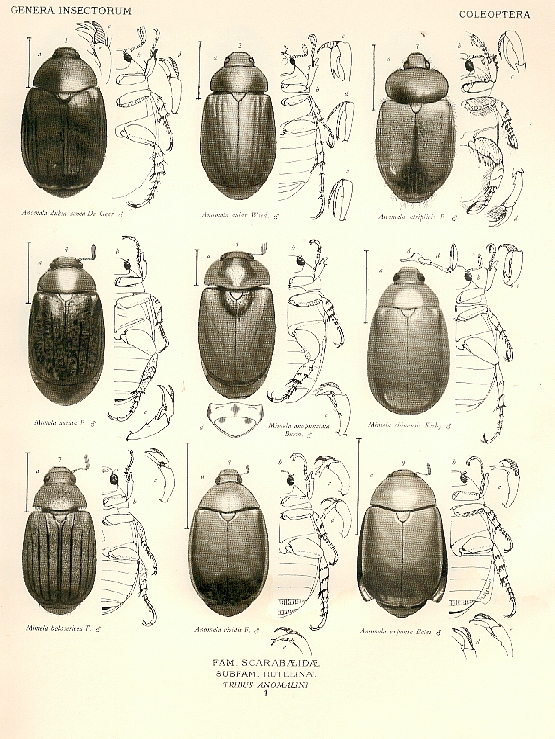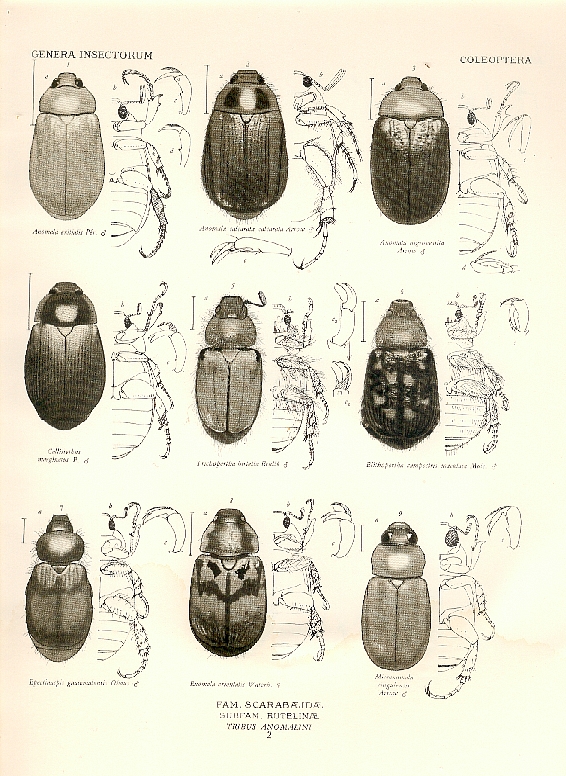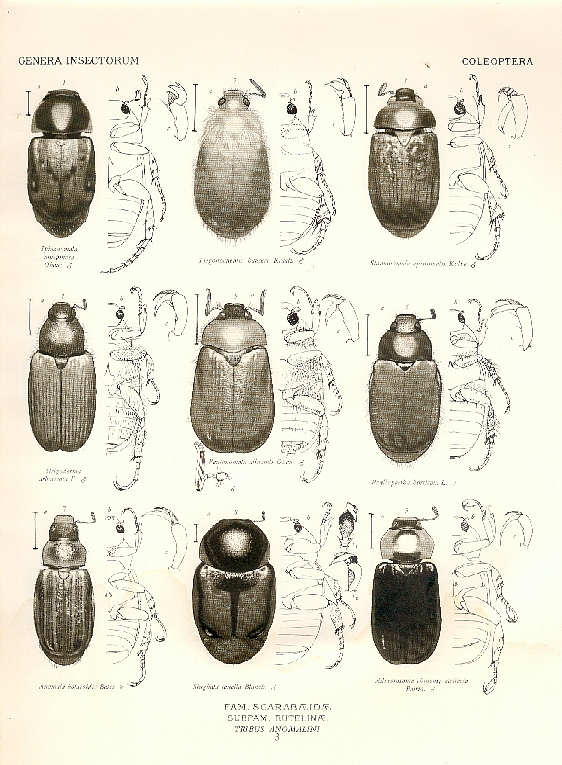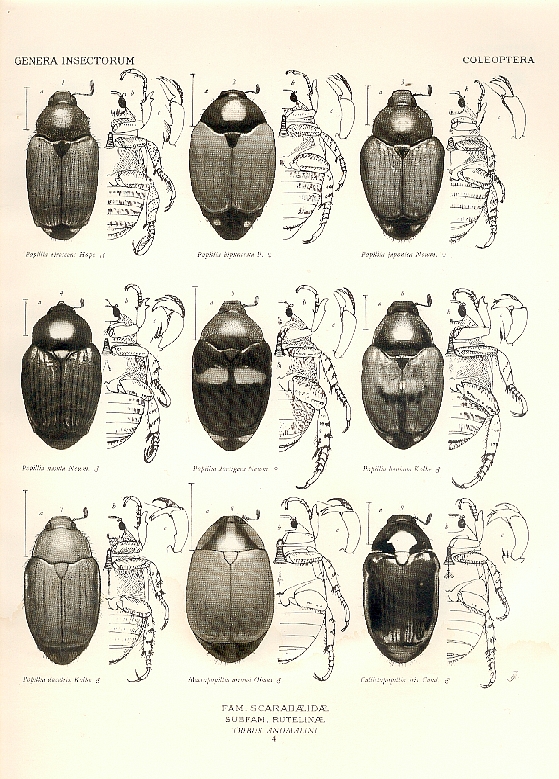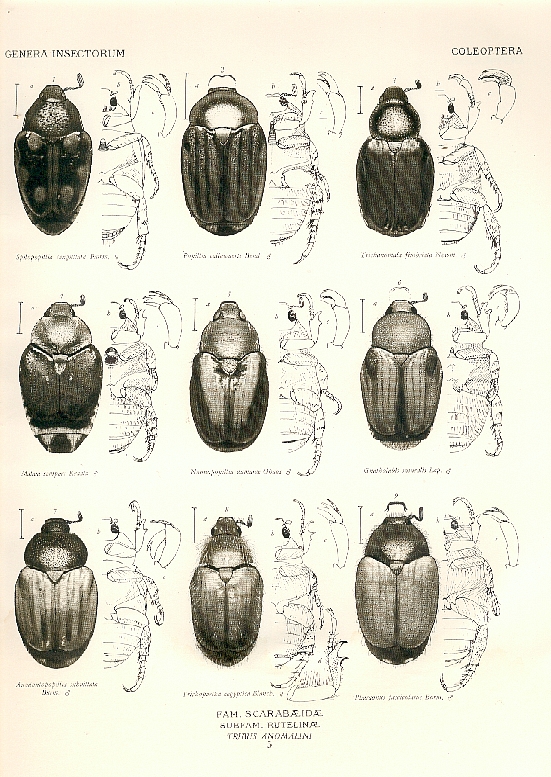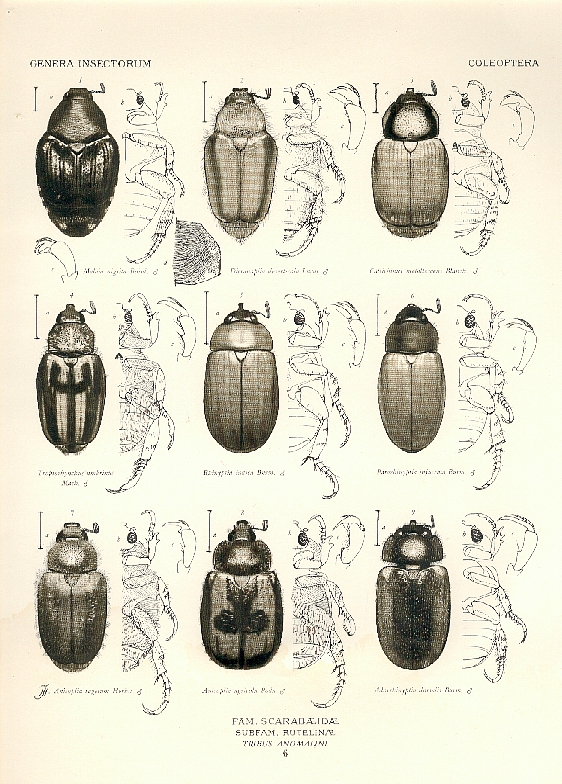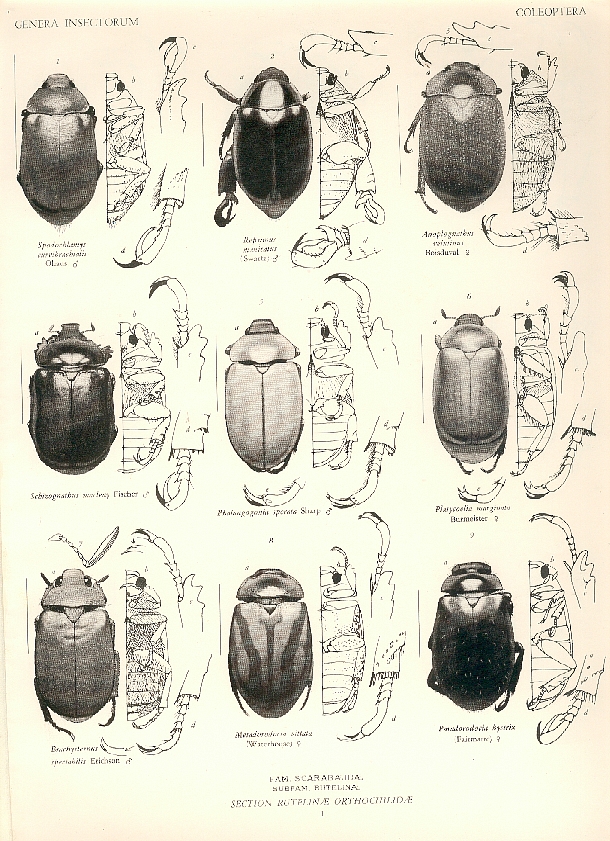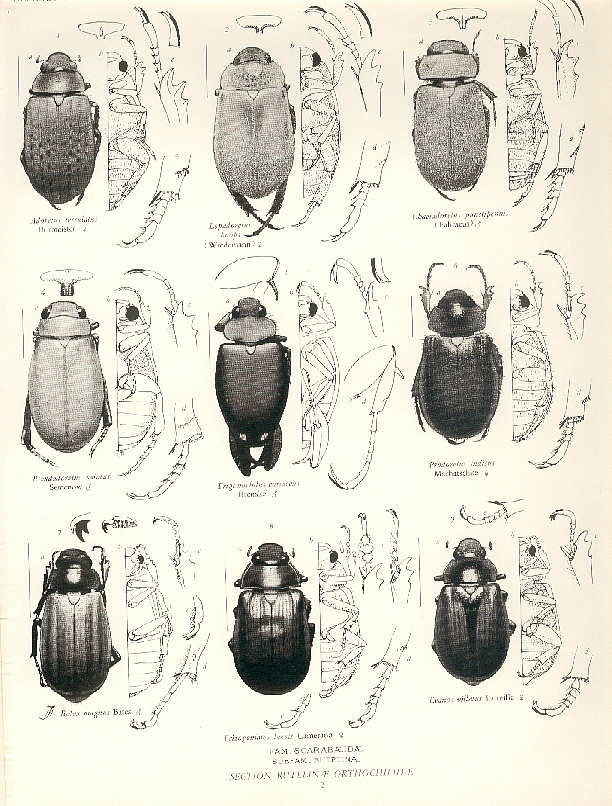RUTELINAE GALLERY
|
Chrysina (RUTELINAE : RUTELINI : PELIDNOTINA)
RUTELINAE STAMPS
Larves de Rutelinae
Chrysina Beetles of the World
Reconnaître les
Chrysina :
Ce sont des RUTELINAE : griffes inégales et articulées, en particulier sur les pattes postérieures !
Ce sont des RUTELINI : labre horizontal, n'adhérant que peu au clypéus !
Ce sont des Chrysina : bord externe de la mandibule non échancré :
Et
: Le quatrième article des tarses des pattes postérieures porte une saillie
pointue et dentelée sur l'angle ventral et 2 éperons de chaque côté qui sont de
longueur et d'épaisseur différentes Les belles "américaines" !
Now I regard species of Chrysina at my lights simply as
old friends and no longer feel the urge to collect them in long series, if
at all. I have heard stories of collectors and dealers with considerably
less restraint collecting hundreds of specimens from the same mountain
canyons, year after year. This annual carnage has led some people to wonder
out loud whether or not Arizona’s Chrysina are in real need of some
sort of legal protection. Nearly 30 years ago, Arnett and Jacques (1981)
declared that both C. beyeri and C. gloriosa,
which they mistakenly thought were the only species in the United States,
were “…endangered and should not be collected.” However, on a warm and dry
night in Madera Canyon this past July, all three species of Arizona’s Chrysina turned up at my light in good numbers. One species, C.
gloriosa, was there in incredible abundance. Still, it would be
worthwhile for a university or governmental agency to study the overall
impact of intensive collecting on Chrysina populations in Madera
Canyon and other popular collecting sites in southeastern Arizona.
Une nouvelle Chrysina du Guatemala !
Les hétérosternides :
Vous trouverez d'autres magnifiques photos de Rutelinae du Guatemala sur le site de notre collègue et ami José Monzon Rutelinae divers
de notre collègue vénézuelien Leopoldo Alfirio Russo Fernandez
Ces deux dernières photos empruntées au nouveau site de
nos collègues paraguayains :
Gleaming beetles from
Central America attract insect enthusiasts and offer hope for saving a
priceless habitat. In a world among
the clouds, entomologist David Hawks and I keep watch for the brilliant
jewel scarabs of Honduras’s tropical montane forests. We wait like fishermen
with nets cast, standing beside lighted white bedsheets spread on the
ground. When the jewels fly in, raining color against the cloth, we feel
like kids again.
Allez voir le magnifique site de A. Solis sur les Chrysina ( = Plusiotis) du Costa Rica : http://www.inbio.ac.cr/papers/Plusiotis/Chrysina.html#Presp et sur tous les scarabées (dont les Rutelinae; magnifiques photos...!) :
http://living-jewels.com Sur tous les insectes des USA et
du CANADA (avec beaucoup de belles photos de RUTELINAE néarctique) : Une nouvelle superbe galerie de nos collègues américains : http://www-museum.unl.edu/research/entomology/Guide/Scarabs%20Gallery/index.html
http://www.philippeblanchot.com/ Anoplognathus australiens ou Chrismas beetles : Ces autres superbes Rutelinae "sortent", en Australie, au moment de Noël, durant leur été à eux, notre hiver à nous ! Les 4 photos qui suivent sont empruntées au très beau site de notre collègue australien Peter Chew : http://www.brisbaneinsects.com/
Ce sont des bêtes qui peuvent pulluler à l'époque de Noël en causant des dommages aux eucalyptus ! Beaucoup d'autres Rutelinae australiens sur : http://pagesperso-orange.fr/virtual-beetles/indexb.html
Le rêve ! You may well ask “Just what the heck is a weevil person doing writing an article in Scarabs?”
Well, this past summer I had the opportunity to visit the
southern state of Chiapas, México and on one fine sunny day high in the
mountains I experienced what can only be described as the scarab
collector’s wet dream! Let me tell you about it. For a number of years I
have been working in Chiapas in collaboration with ECOSUR, a small
college located in San Cristobal de las Casas in the Altos of Chiapas.
My project has been surveying the leaf litter inhabiting weevils of mid
and high elevation forests. We’ve been fortunate to visit and sample
numerous forests, some only small fragments, and many otherwise
inaccessible unless one has proper permission from the indigenous
inhabitants. Often this requires meetings with officials from the local
ejido, then a town meeting to approve permission. But enough of
logistics, let’s get to the real story!One area we have worked is the La
Sepultura Biosphere Reserve, located about 25 kilometers southwest of
the town of Villaflores in the Sierra Madre de Chiapas of western
Chiapas. We work out of a small town named Sierra Morena at about 1,200
meters elevation. Sierra Morena sits in a valley between two higher
mountains, Cerro Bola to the south and Tres Picos to the north. Cerro
Bola (16º.13464 N 93º.60077 W) is just under 2,000 meters and is a nice
sharp peak with a definite summit. Leaf litter faunas change as one
moves up in elevation so this one day, June 14, we thought it worthwhile
to spend the 3 hours to walk up to the peak and take some samples, which
we suspected would be quite different from the samples from between
1,400 meters and 1,600 meters we had previously taken. The day was sunny
and the rains had not yet arrived so things were quite dry. Quite a few
trees had not leafed out and the litter was dry and sandy. When we
arrived at the peak we noticed that the litter here was moister, perhaps
due to clouds collecting at the summit and depositing moisture in the
form of mist or light rain. Within a few minutes of our arrival my keen
coleopterological eye spotted a large green beetle on a leaf about 10
feet up in one of the taller trees right at the peak. I asked one of my
much younger, spry and lighter colleagues if he could climb up that tree
and fetch me that beetle. “Sure” he said and promptly scaled the trunk.
As he reached out for the beetle he commented “There’s another one over
there” and pointed to another, clearly visible on another leaf. He then
noted as he scanned the upper foliage of the tree that “there are quite
a few of these up here.” I approached him and peered up to get a better
look. Sure enough I could now see about 10 or more beetles clinging to
the branches and leaves of the tree. “Why don’t I just shake the tree
and they should fall down?” he asked. I agreed that this seemed a
suitable arrangement, so he shook the tree. At this point I must suggest
that the true scarab enthusiast find a comfortable seat, sit down, close
your eyes, relax and try to imagine this scenario. Picture the tree
shaking and the large, bright green beetles falling. First one or two,
then 10, 20… then a hundred, then hundreds. It was literally raining
Chrysina!!
(Dans l'excellente revue Scarab's de nos collègues américains)
Notre collègue
et ami Conrad Gillett au Belize (Las Cuevas) :
Voir le très curieux site : http://insectlabstudio.com/collection/Beetles/ Le Genera Insectorum d'Ohaus (1934) :
Mesystoechus ciliatus Water., Cotalpa lanigera L., Byrsopolis castanea Burm., Areoda banksi Lap., Paracotalpa granicollis Hald., Hoplognathus kirbyi M. L., Macropoides mniszechi Sallé, Parachrysina trucquii Thoms., Parisolea pallida Cand., Xenoproctis ohausi Kolbe, Acrobolbia macrophylla Ohaus, Parhoplognathus mexicanus Ohaus, Peltonotus nasutus Arrow, Heterosternus rodriguezi Cand., Eremophygus philippii Ohaus.
Oogenius chilensis Ohaus, Hoplopelidnota candezei Bates, Mesomerodon spinipenne Ohaus, Plusiotis adelaida Hope, Chrysina erubescens Bates, Pseudogeniates richteri Ohaus, Pelidnotopsis plusiotina Ohaus, Chrysophora chrysochlora Lat., Ectinoplectron oryctoides Ohaus, Homonyx chalceus Blan., Heteropelidnota kuhti Ohaus, Mecopelidnota arrowi Bates, Catoclastus chevrolati Sol., Pelidnota sumptuosa Vigors, Homothermon serrano Ohaus.
Lasiocala fulvohirta Blanch., Peperonota harringtoni Westw. (ssp. assamensis Ohaus), Dicaulocephalus fruhstorferi Felsche, Ceroplophana modiglianii Gestro (ssp. borneensis Ohaus), Rutelarcha quadrimaculata Water., Parastasia burmeisteri Ohaus, Oryctomorphus maculicollis Guérin mâle (vers DYNASTIDAE !), Oryctomorphus maculicollis Guérin femelle, Desmonyx humeralis Arrow, Fruhstorferia sexmaculata Kraatz, Metapachylus sulcatus Bates, Rutela histrio Sahlbg., Rutelisca florhi Bates, Chlorota haemorrhoidalis Olivier, Cyphelytra ochracea Water.
Crathoplus squamiferus Blanch., Thyridium sapphirinum Non., Hypaspidius crassus Ohaus, Acraspedon sulcipenne Waterh., Chalcentis victima Germ., Ptenomela gratiosa Sharp, Aequatoria pretiosa Brem., Calomacraspis haroldi Cand., Vayana bicolor Ol., Anticheira adamsi Waterh., Lagochile trigona Herbst, Telaugis aenescens Burm., Paratelaugis robusta Kirsch, Chasmodia divisa Ohaus, Macraspis splendida Fabr. Genera de Machatschke (1957) : RUTELINAE HOMALOCHILIDAE : ANOMALINI
Anomala dubia aenea De Geer, Anomala aulax Wied., Anomala atriplicis F., Mimela aurata F., Mimela anopunctata Burm, Mimela chinensis Kirby, Mimela bolosericea F., Anomala viridis F., Anomala expansa Bates
De gauche à droite et de haut en bas : Anomala exitialis Pér., Anomala calcarata calcarata Arrow, Anomala nigrovestita Arrow, Callisthetus marginatus F., Tricopertha hirtella Brullé, Blithopertha campestris maculata Muls., Epectinaspis guatemalensis Ohaus, Exomela orientalis Waterh., Micranomela cingulensis Arrow
Spinanomala unispinosa Ohaus, Trigonocnemis hauseri Kraatz, Stomanomala epistomalis Kolbe, Strigoderma arboricola F., Pentanomala alluaudi Ohaus, Phyllopertha horticola L., Anomala bolacoides Bates, Singhala tenella Blanch., Adoretosoma chinense atritarse Fairm.
Popillia virescens Hope, Popillia bipunctata F., Popillia japonica Newm., Popillia nasuta Newm., Popillia dorsigera Newm., Popillia beniana Kolbe, Popillia ducatrix Kolbe, Macropopillia arrowi Ohaus, Callistopopillia iris Cand.
Spilopopillia sexguttata Fairm., Popillia callewaerti Bend., Trichanomala fimbriata Newm., Malaia semperi Kraatz, Nannopopillia damarae Ohaus, Gnatholabis suturalis Lap., Anodontopopillia subvittata Burm., Trichopertha aegyptica Blanch., Pharaonus fasciculatus Burm.
Malaia nigrita Boisd., Dicranoplia deserticola Lucas, Callirhinus metallescens Blanch., Tropiorhynchus umbrinus Mach., Rhinyptia indica Burm., Pararhinyptia infuscata Burm., Anisoplia segetum Herbst, Anisoplia agricola Poda., ADORRHINYPTINI, Adorrhinyptia dorsalis Burm. Genera de Machatschke (1965) :
SPODOCHLAMYINI, Spodochlamys curvibrachialis Ohaus, ANOPLOGNATHINI, Repsimus manicatus (Swartz), Anoplognathus velutinus Boisduval, Schizognathus macleayi Fischer, Phalangogonia sperata Sharp, Platycoelia marginata Burm., Brachysternus spectabilis Erichson, Metadorodocia vittata (Waterh.), Paradorodocia hystrix (Fairm.)
ADORETINI, Adoretus tessulatus Burm., Lepadoretus boops (Wiedemann), Chaetadoretus punctipennis (Fahraeus), Pseudadoretus validus Semenow, Trigonochilus coriaceus Brenske, Prodoretus indicus Machat., Bolax magnus Bates, Trizogeniates laevis Camerano, Evanos villatus Latreille
|


















